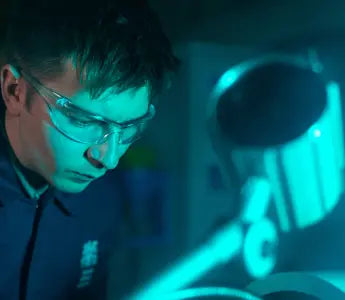
Many common industrial applications call for pure nitrogen or oxygen. Shipping canisters of nitrogen and oxygen to your facility from external suppliers is possible, but it has several disadvantages. High shipping costs add up to high operating costs for the facility, and shipping delays can lead to production delays. Long-distance shipments also consume tremendous amounts of fossil fuels and raise the facility's carbon footprint.
Fortunately, industrial gas generators help resolve these issues, so many facilities that consistently use nitrogen or oxygen will want to install a nitrogen or oxygen generator. But how do you make nitrogen and oxygen gas, and what are nitrogen and oxygen generators used for?
We will answer these questions below.
Table of Contents:
- What Are Nitrogen and Oxygen Generators?
- What Is the Difference Between Membrane and PSA Generators?
- How Do Nitrogen and Oxygen Generators Work?
- What Are Oxygen and Nitrogen Generators Used For?
What Are Nitrogen and Oxygen Generators?
Nitrogen and oxygen generators are pieces of equipment that separate air molecules to produce the gases nitrogen and oxygen.Nitrogen Generators
What is the purpose of a nitrogen generation system? Many businesses require nitrogen to help their processes run smoothly. For example, the food and beverage industry often uses nitrogen in canning, bottling and preserving food products, as well as in freezing food products.
Much of the air we breathe — about 78% — is nitrogen. Oxygen accounts for only about 21% of the air. A nitrogen generator works by separating the nitrogen molecules from the air and creating a pure, concentrated volume of nitrogen that the facility can use. A nitrogen generator is relatively quick and easy to install, and it makes using nitrogen in industrial applications more convenient.

Oxygen Generators
Oxygen generators work similarly to nitrogen generators — they isolate oxygen molecules and separate them from the rest of the air, creating a pure form of oxygen that can be used in industrial applications.
As with nitrogen, shipments of oxygen from external suppliers can be cost-prohibitive, and many facilities prefer to control their own schedules rather than having to wait for a delivery. Having an oxygen generator installed gives facilities the freedom and convenience of having a supply of oxygen on hand whenever they need it — and at an extremely reasonable cost.
What Is the Difference Between Membrane and PSA Generators?
Two common types of industrial gas generators are membrane generators and pressure swing adsorption (PSA) generators. But what's the difference between these two different types?
Membrane Generators
A membrane nitrogen generator makes use of a permeable membrane as its main component. The membrane is typically filled with thin, hollow fibers. As compressed air enters the filter, it flows to the edges of the membrane fibers through a process known as permeation. Different molecules permeate the membrane at different speeds — water, oxygen and carbon dioxide permeate quickly, argon permeates more slowly, and nitrogen permeates more slowly still. So during permeation, the fibers convey substances such as water, oxygen, carbon and some argon out of the membrane, leaving primarily nitrogen and a little argon behind.
The housing of the membrane generator contains an orifice known as the permeate vent. This opening allows the oxygen, carbon and argon to escape so that these gases don't build up too much pressure in the generator and reduce the efficacy of the membrane.
For membrane generators to work properly, the compressed air that flows into them needs to be clean and dry — if not, it will clog the membrane fibers. Water vapor is fine for the generator, but it cannot handle even small amounts of liquid water. Some membrane generators come with built-in filters and dryers, but others may require the installation of filters and dryers between the generator and the air compressor before the generator can run. Whatever the setup, it's important to provide clean, dry intake air to keep the generator and its membrane running smoothly and ensure a long lifespan.
Pressure Swing Adsorption (PSA) Generators
A pressure swing adsorption generator, or PSA generator, uses pressure swing adsorption technology. A PSA nitrogen generator, for example, works by using a carbon molecular sieve (CMS) to adsorb, or bind to, the oxygen, argon and carbon molecules in the air. The CMS removes the other molecules from the stream of compressed air flowing through the generator and leaves a pure stream of nitrogen behind.
A PSA nitrogen generator typically contains two vessels, or towers, that contain CMSs. Most CMSs are made of anthracite coal with an effective pore diameter of 0.4 to 0.9 nanometers. The other molecules bind to the CMS, but nitrogen molecules are too big to fit into the pores, so they pass by unimpeded. At this point, most of the nitrogen stream flows out of the tower — it is ready for the facility to use it.

After the CMS adsorbs the oxygen molecules in the first tower, however, a small amount of the air continues into the second tower, which has also been adsorbing oxygen and generating pure nitrogen. The small stream of air flows in the opposite direction from the flow of the initial stream of air. By flowing in the opposite direction, this small stream of air dislodges all the oxygen particles that the CMS had previously absorbed. This action regenerates the CMS and enables it to adsorb more oxygen and keep producing more pure nitrogen.
When the small stream of nitrogen dislodges the oxygen molecules from the second tower, the pressure inside the two towers equalizes. Once the pressure has equalized, the two towers also change phases — the tower that had been full of oxygen and regenerating starts adsorbing, and the tower that had been adsorbing and producing nitrogen, and is now full of adsorbed oxygen, starts regenerating. This alternation of phases is called a "swing of pressure" and is the reason the technology is called "pressure swing adsorption."
What is a PSA oxygen generator, and how is it different? A PSA oxygen generator is similar to a PSA nitrogen generator but sometimes uses zeolite rather than a CMS.
Differences Between PSA and Membrane Generators
What are some of the advantages of PSA vs. membrane nitrogen generators and membrane oxygen generators?
Membrane generators offer a few different advantages over other types of generators — they tend to perform better at higher temperatures, for one thing. They have a simpler design and operating procedures, so they require less maintenance, run up fewer repair costs and have smaller installation footprints. This latter property makes them ideal for installations in cramped or crowded spaces. They also start up relatively quickly and quietly, offer reliable pressure and flow stability and can run without electricity.
Pressure swing adsorption is essential in applications that require a high level of purity of the nitrogen or oxygen produced. In some applications, such as filling tires, the level of gas purity is less important. But in certain applications, such as food and beverage packaging or pharmaceutical manufacturing, the purity of the gas produced is critical. A PSA generator can achieve pristine purity levels — up to 99.999%, slightly higher than the 99.5% purity a membrane generator is capable of. If your applications require a high-purity nitrogen generator or a high-purity oxygen generator, a PSA generator is an excellent way to go.
One of the main advantages of a PSA generator is that it has a lower air factor than membrane generators. Having a low air factor means the generator requires a lower volume of compressed air to produce the same amount of nitrogen or oxygen. Using less compressed air means consuming less energy, which in turn means greater cost savings and a lower environmental impact. A PSA generator can also generally supply higher volumes of nitrogen than a membrane generator can.
One other advantage of using a PSA generator in industrial applications is that it is slightly less sensitive to water than a membrane generator.

How Do Nitrogen and Oxygen Generators Work?
As we have seen, nitrogen and oxygen generators work by separating different molecules out of a flow of air and leaving a pure stream of nitrogen behind. They do not create nitrogen or oxygen — instead, they extract nitrogen or oxygen from the air and store it in a pure form. The operator of the industrial gas generator can specify what purity the machine produces — some applications, such as food and beverage packaging, require a much higher purity level than others.
Nitrogen and oxygen generators typically use either the membrane system or the PSA technology described above.
Nitrogen Generators
How do nitrogen gas generators work? A nitrogen generator typically has several different components that work together to provide on-site nitrogen generation. These can include a feed air compressor, a dryer, an air storage tank, the main nitrogen generator and a nitrogen surge tank.- Feed air compressor: The feed air compressor takes air from the environment and compresses it to a specified pressure in pounds per square inch (psi).
- Dryer: The dryer removes moisture from the air so that water and water vapor will not interfere with the generator's operation.
- Air storage tank: The air storage tank holds the compressed and dried air until the main generator system is ready for it.
- Nitrogen generator: This is the area in which the air molecules separate and nitrogen generation takes place. In a PSA system, the nitrogen generator consists of the two towers, and in a membrane system, it consists of the membrane that separates the various molecules.
- Nitrogen surge tank: The nitrogen surge tank stores nitrogen between the time when it is discharged and the time when the facility will use it. The nitrogen surge tank is also useful for reducing pressure rise by increasing the amount of volume in the system.
Oxygen Generators
The layout and operation of an oxygen generator are a little different from the layout and operation of a nitrogen generator. An oxygen generator typically consists of a few different components that function to provide on-site oxygen generation: a feed air compressor and an oxygen generation unit, and then an optional cylinder filling station that includes a booster compressor and a cylinder filling bank.- Feed air compressor: The feed air compressor sucks in air and compresses it to the desired pressure.
- Oxygen generation unit: This unit strips nitrogen and other particles out of the air stream, leaving pure oxygen behind.
- Booster compressor: The booster compressor allows for increasing the pressure capabilities of the primary air compressor.
- Cylinder filling bank: The cylinder filling bank allows for the storage of higher volumes of pure oxygen for high-flow applications.

What Are Oxygen and Nitrogen Generators Used For?
Industrial gas generators find uses in a range of different industries. A few of these are listed below.
Electronics Manufacturing
Electronics production relies on pure nitrogen in several different processes, including selective soldering, wave soldering, brazing and more. The advantages of using nitrogen include improved wetting, improved yield and quality, reduced solder balls, reduced icicling, improved surface finish for solder joints and many other benefits. Using an in-house nitrogen generator helps production facilities gain these benefits at a lower cost and without the risk of shipping delays.
Food and Beverage Production
The food and beverage industry commonly uses pure nitrogen for processing, packaging and bottling processes. Air that contained oxygen could quickly lead to food spoilage and decay, but air that contains pure nitrogen keeps foods stable and fresh. Production facilities use nitrogen to improve the shelf life of many foods, preserve foods for transport and eliminate the bacteria that cause many foods to perish. Because nitrogen is an inert gas, it is also useful in the food and beverage industry for creating the inert environment necessary for processes like the cold storage of produce and the loading and offloading of tankers.Hospitals and Medical Facilities
Hospitals and medical facilities use oxygen generators to produce pure oxygen for patients to breathe in intensive care and during surgery and other procedures when breathing may become compromised. Because patient health and safety are paramount, the use of oxygen generators is widespread — oxygen generators are safer than cryogenic oxygen tanks or pressurized cylinders. Oxygen generators are also more convenient and economical than having shipments of oxygen shipped in from external suppliers. Pharmaceutical manufacturing facilities also commonly use nitrogen generators. Nitrogen is useful for making blister packaging and vaccine vials inert, and it can also help stabilize reactive substances to prevent fires and explosions.Laboratories
Nitrogen is useful in the laboratory for similar reasons. It helps laboratories provide the specific environmental conditions necessary for sensitive equipment and processes, such as cell incubators and mass spectrometers. It also helps stabilize substances that could become explosive in the presence of oxygen. Labs that use in-house nitrogen generators eliminate their need to rely on pressurized gas cylinders, which can be extremely hazardous.

Partner With Fluid-Aire Dynamics for All Your Industrial Gas Generator Needs
When you're looking for a nitrogen or oxygen generator for your facility, let Fluid-Aire Dynamics be your trusted source. Our efficient, state-of-the-art industrial generators will help you reduce your energy consumption and provide you with high-quality nitrogen or oxygen to help enhance your facility's processes and overall operation.
Our knowledgeable design, engineering, installation and maintenance teams have years of product expertise and can assist you in finding the industrial gas generator that works best with your applications. We can help with the energy management of your industrial gas generator's compressed air system as well.
Contact us today to learn more.





